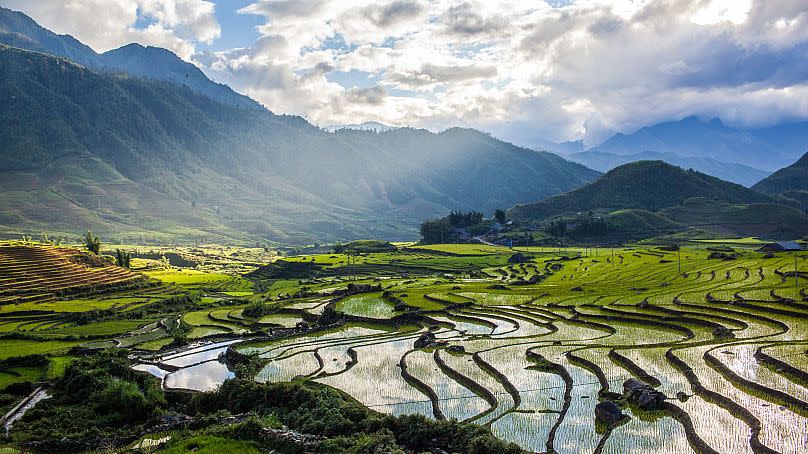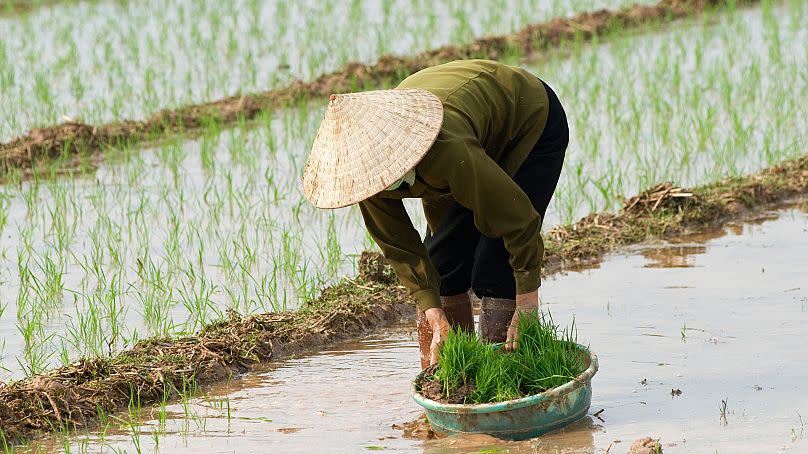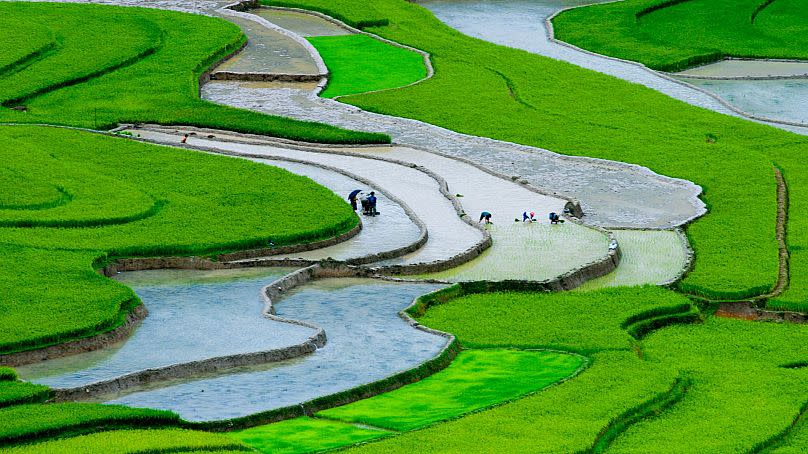Rice feeds nearly half the world’s population, but the way we grow it has a surprisingly high methane footprint.
According to a report by the Global Climate and Health Alliance, eight percent of the 42 percent of global methane emissions caused by agriculture come from rice cultivation.
Farmers produce rice by flooding their rice fields, which creates anaerobic conditions in which microorganisms methane – a potent greenhouse gas with a warming potential 80 times that of CO2 during the first 20 years after it is emitted.
Methane’s short-term power makes it a major driver of global warming, but it also means that small gains can be made quickly if emissions are reduced.
In IndonesiaRize helps farmers adopt new farming methods that can reduce emissions in the region and increase farmers’ profits.
“The idea for Rize came about because rice, second cattle“is the biggest emissions problem in agriculture in Southeast Asia,” says Siem Schreurs, the startup’s partnerships lead. “The problem is easier to address from a rice perspective.”
Part of Rize’s strength, Schreurs says, is its focus on collaborating with small-scale farmers. farmersbuilding on CEO Dhruv Sawney’s previous experience with ‘nurture.farm’ (an Indian sustainable farming app that attracted 1.5 million smallholder farmers).
“There is a lot of good work being done by NGOs or development agencies trying to help farmers adopt new durable “There are practices, but adoption rates outside of these programs are generally very low,” says Schreurs.
“We really do everything we can to get the right technology to farmers and ensure that they use it for the long term.”

Why does rice produce so much methane?
Rice is not necessarily a high-emitting crop, said Gabriel Vegh-Gaynor, co-author of the Global Climate and Health Alliance paper about methane management.
It has more to do with the flood engineering which has crystallized in rice fields over the centuries and is used to repel pests and prevent weed growth from depleting the soil’s nutrients.
“It’s a natural process when you decompose organic matter in low oxygen environments,” Vegh-Gaynor says. “For antigenic organisms, that’s an environment where they thrive and they’re going to methane under those circumstances.”
The problem is compounded by the scale of rice production. More than 3.5 billion people are thought to get 20 percent of their daily calories from rice, and demand for it is growing.
But this cutting staple food would hardly be fair. Vegh-Geynor mentions Bangladesh, where almost half of rural employment comes from rice production. “Rice provides two-thirds of all the calories that people in the country consume.”
There is not much urgency to stop the rise of rice in the markets, Vegh-Gaynor adds. “If you look at kilocalories per emissions unit that is produced for that food, it is extremely efficient,” he says. “It is one of the most efficient foods in terms of emissions.”
The growth of rice can even be a boon for methane reduction, as new businesses emerge to meet the world’s growing demand.
“The opportunity is not so much in the specific size of production, but more in the fact that new markets are opening up and you can get in on the ground floor with alternative methods,” Vegh-Gaynor said.


How Rize is reducing rice’s methane problem
Continuous flooding can be a labor-intensive process, requiring pumps to replenish the water. water lost through evaporation and thirsty rice plants.
But across Vietnam and Indonesia, Rize is testing a different technique with farmers This is called alternate wetting and drying (AWD), where the rice fields are allowed to dry out before more fresh water flows in.
Research has shown that AWD reduces the chance of an accident. methane emissions by 50 percent, which Rize hopes to improve with further laboratory testing.
“We can test for AWD with one drying event versus AWD with two drying events,” says Schreur. “Or we can organic coal to the bottom – what would be the effects?”
The results so far are promising, with a 35 percent drop in emissions recorded. But according to Schreur, the real value of AWD lies in the benefits it brings to farmers.
“The root of a plant when you expose it to fear of water “For example, you let the rice dry for X days – it actually grows more because it seeks more water,” he explains. “When you re-water, there are more roots, which leads to more plant growth, which leads to more yield.”
By pumping less water, this higher harvest yield is also combined with energy and water conservation: an attractive business proposition for the small farmers Rize works with.
“It basically means you install a pipe and make sure there is no water in the field for certain periods of time,” says Schreur, “so the adoption rate for these technologies is much higher.”
Rize helps farmers make profits while reducing emissions
According to Schreur, creating a winning financial incentive is essential to retain farmers once they have implemented AWD.
Before the start of the season, smallholder farmers need to purchase essential inputs such as rice seeds, fertilizers and pesticides.
“This could add up to around $600 [€550] per hectare per season,” Schreur explains. “They don’t have the liquidity to pay it up front, so they take out a loan with sometimes 10 to 15 percent interest costs.”
To solve this financial problem, Rize buys these inputs in bulk. This means that the farmer can buy them at a reduced price, without any additional interest.
A devotee agronomist – an expert in crop production, soil and pest control – is then assigned to each farm to assist with the transition, oversee the installation of the pipes and advise the farmer.
“At the end of the harvest, the farmer will say, ‘Hey, these guys put their money in my soil. They had their people come in and work with me through this whole process,’” Schreur says. “All the implementation needed for AWD is in our books.”
To give AWD extra staying power, Rize is working with existing networks among farmers.Farmers groups “We usually have a long-term relationship with these farmers and these parties have a lot of influence,” says Schreur.
In Vietnam, he explains, farmers are often coordinated by government-appointed farmer cooperatives, which oversee the irrigation of ten to a hundred farms.
Rize organizes onboarding sessions with these cooperatives, where they share the benefits of the technology. This can happen in multiple sessions, creating a lasting connection with the community.
“It is a continuous building of trust on our part,” says Schreur.


How data collection can help rice farmers improve their harvests
According to Vegh-Gaynor, there is one area of rice production that shows particular promise: data collectionwhich can help farmers improve their harvest with targeted feedback.
“We can get more data on very region-specific methods and what has worked in those contexts, which will allow others to succeed without some of the challenges of early adopters,” he says.
For Rize, this data supports agronomists, who monitor growing conditions and water usage on each farm.
“You could call it a tech-enabled agronomic model,” says Schreur. “We track all the contact moments the agronomist has with the farmer. All the data is then recorded in our platform, which will ultimately help us make better decisions.”
This data could ultimately pave the way for more investment. By demonstrating the success of sustainable farming practices, Rize can present smallholder farmers as a low-risk market.
“There is not much data on small farmers, especially those who are switching to a different way of farming,” says Schreur.
“All the data points we collect can be useful for insurance players or microfinance institutions that want to deploy capital to smaller farmers.”
Awareness of methane emissions is growing, but supermarket brands must join in
Rize’s work on the ground is a good start, but a more collaborative approach is needed to get to the heart of Rice’s methane problem.
“We are a small agri-tech that is tackling a big problem,” says Schreur. “There needs to be more power from a downstream perspective, meaning companies like FMCGs, traders, buyers – the larger companies that buy large volumes of rice.”
In 2021, 111 countries signed the Global Methane Pledgewho are committing to reducing their methane emissions by 30 percent by 2030. This increased awareness is promising, says Schreur, but it must impact the brands we see in the marketplace. supermarket planks.
“There is still a huge demand for low-quality, high-emission rice,” he says. “A lot more effort needs to be made to transform the entire value chain.”